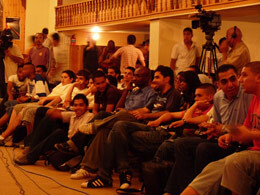The Electronic Intifada 12 June 2009

The DARG Team and friends at Hip Hop Kom. (Jordan Flaherty)
The Maqusi Towers in Gaza City look a bit like US housing projects. The neighborhood consists of several tall apartment buildings grouped together in the northern part of town. It is also ground zero for Gaza’s growing Hip-Hop community. On a recent evening in one small but well-decorated apartment, a dozen rappers and their friends and families relaxed, danced, smoked flavored tobacco, and rapped the lyrics to some of their songs.
The occasion was a post-show celebration of the taping of Hip Hop Kom, an “American Idol”-type talent competition for Palestinian rappers. Fifteen acts from across Palestine performed on Thursday night, and the show was broadcast simultaneously in Gaza City and the West Bank city of Ramallah. Through the use of video conferencing and projection, each city could see and hear the performances happening in the other. Five groups from Gaza participated, and Gazans came in first, third, and fourth place.
The Gaza City show was held in a small theatre in the Palestine Red Crescent building. Although only publicized by word of mouth, nearly 200 young people filled the theatre, loudly cheering for the rappers and breakdance crew who took the stage.
One of the organizers of the contest, a charismatic literature major named Ayman Meghames, is a minor celebrity here. Part of Gaza’s first Hip-Hop group — named PR: Palestinian Rapperz — Ayman dedicates his time to supporting and publicizing Gaza’s young music scene.
Armed with a ready smile, Ayman was seemingly everywhere at once that night. He was on stage introducing the acts, helping with technical difficulties, greeting friends, and coordinating with the West Bank organizers.
For Ayman, making music is a form of resistance to war and occupation, and also a tool to communicate the reality of life in Palestine. “Most of our lyrics are about the occupation,” he tells me. “Lately we’ve also started singing about the conflict between Hamas and Fatah. Any problem, it needs to be written about.” Rapper Chuck D, from the group Public Enemy, once called rap music the CNN for Black America. For Ayman and his friends, music is their weapon to break media silence. “Most of the world believes we are the terrorists,” he says. “And the media is closed to us, so we get our message out through Hip-Hop.”

The audience at Hip Hop Kom in Gaza City. (Jordan Flaherty)
As the evening progressed, the energy in the room continued to rise. The next act featured six members from two combined groups (DA MCs, and RG, for Revolutionary Guys) now collectively called DARG Team. The crowd was up on their feet, many of them singing along as the performers displayed a range of lyrical stylings.
In Mohammed Wafy’s apartment, the performers waited anxiously for the results of the contest. The call came in on Ayman’s cel phone. Putting it on speaker, everyone listened as the results were announced: DARG team had come in first place, and Black Unit had placed third. There were no hurt feelings apparent for those that didn’t win — for these young performers, every victory is a shared victory. DARG members will now go on to Denmark to produce an album (if they can get out of Gaza).
Fadi Bakhet, a studious and slightly preppy looking Afro-Palestinian in wire-rimmed glasses, is DARG’s manager, and also the brother of one of the members. As the night continued, the gathering moved to his apartment. They celebrated the successful show, which also fell on the last day of exams for many students, and the laughing and conversation continued late into the night. The next day was hot and sunny, and thousands of Gazans gathered on the beach to swim and relax by the Mediterranean.
These stories may seem incongruent with much of the international reporting about Gaza and the Hamas government. But it is exactly for this reason that they should be told.
If you follow the reporting on Palestine in the US media, you may imagine a fundamentalist state. Hamas-stan, as at least one Israeli commentator has called it. You may imagine a nation of terrorists, where women are oppressed and men launch rockets. But perhaps when we learn that Palestinian families swim on Friday afternoons, that they study literature in the day and rap about imprisoned friends at night, we can rethink the America’s unquestioning support for Israeli aggression against this almost entirely defenseless population.
Yesterday, I visited a journalism class at the Islamic University, taught by Rami Almeghari. The students had many questions, but one young woman’s words in particular stayed with me. “What can we do to reach people in America and tell them how things really are here,” she asked. “How can we get them to listen, and to see?”
Jordan Flaherty is a journalist based in New Orleans, and an editor of Left Turn Magazine. Â He was the first writer to bring the story of the Jena Six to a national audience and his reporting on post-Katrina New Orleans shared a journalism award from New America Media. His work has been published and broadcast in outlets including Die Zeit (in Germany), Clarin (in Argentina), Al-Jazeera, TeleSur, and Democracy Now. He is currently traveling in Gaza with a delegation of journalists, organizers and human rights workers from the US south. He can be reached at neworleans@leftturn.org.



